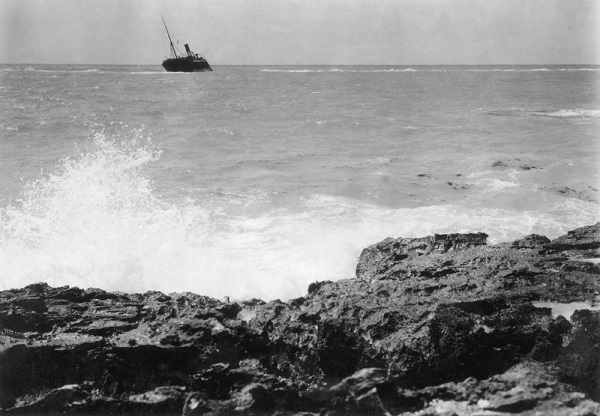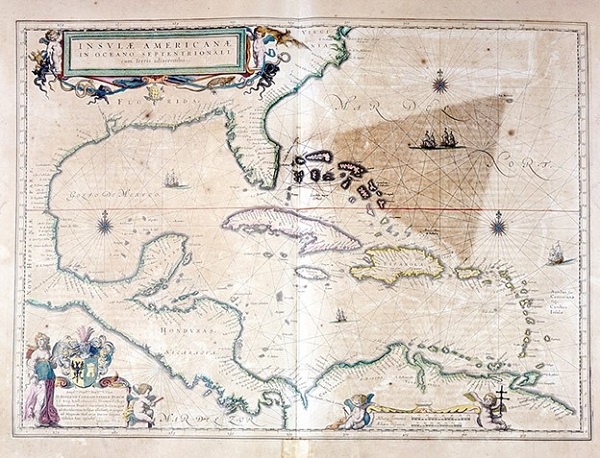Hillary Mayell reports for National Geographic: “Numerous ships and planes have vanished without a trace within the imaginary Bermuda Triangle bounded by Miami, Bermuda, and Puerto Rico. What caused these disappearances remains a mystery.” Here are excerpts from Mayell’s “The intrigue behind the Bermuda Triangle.”
On a sunny day nearly 80 years ago, five Navy planes took off from their base in Florida on a routine training mission, known as Flight 19. Neither the planes nor the crew were ever seen again.
Thus was a legend born. The Bermuda Triangle is an area roughly bounded by Miami, Bermuda, and Puerto Rico. No one keeps statistics, but in the last century, numerous ships and planes have simply vanished without a trace within the imaginary triangle.
Unusual features of the area had been noted in the past. Christopher Columbus wrote in his log about bizarre compass bearings in the area. But the region didn’t get its name until August 1964, when Vincent Gaddis coined the term Bermuda Triangle in a cover story for Argosy magazine about the disappearance of Flight 19. The article stimulated a virtual cottage industry in myth-making.
Many exotic theories have been propounded to explain what happened to the missing travelers.
The disappearances have been attributed to the machinations of enormous sea monsters, giant squid, or extra-terrestrials. Alien abductions, the existence of a mysterious third dimension created by unknown beings, and ocean flatulence—the ocean suddenly spewing great quantities of trapped methane—have all been suggested as culprits.
The reality, say many, is far more prosaic. They argue that a sometimes treacherous Mother Nature, human error, shoddy craftsmanship or design, and just plain bad luck can explain the many disappearances.
“The region is highly traveled and has been a busy crossroads since the early days of European exploration,” said John Reilly, a historian with the U.S. Naval Historical Foundation. “To say quite a few ships and airplanes have gone down there is like saying there are an awful lot of car accidents on the New Jersey Turnpike—surprise, surprise.”
Lieutenant A. L. Russell, in the U.S. Coast Guard’s official response to Bermuda Triangle inquiries, writes: “It has been our experience that the combined forces of nature and the unpredictability of mankind outdo science-fiction stories many times each year.”
Disappearance of Flight 19
The legend of the Bermuda Triangle will be forever tied to the fateful flight that took place on December 5, 1945. Flight 19 originated at the U. S. Naval Air Station in Fort Lauderdale, Florida. Five TBM Avenger Torpedo Bombers carrying 14 men took off at roughly 2:10 p.m. that day on a routine navigational training mission.
Led by instructor Lieutenant Charles Taylor, the assignment was to fly a three-legged triangular route with a few bombing practice runs over Hen and Chickens Shoals. Taylor, in an age before GPS became commonplace for navigation, got hopelessly lost shortly after the bombing run. Pilots flying over water in 1945 had to rely on compasses and knowing how long they’d been flying in a particular direction, and at what speed.
Both of the compasses on Taylor’s plane were apparently malfunctioning. Transcripts of in-flight communications suggest he wasn’t wearing a watch. There are no landmarks in the middle of the ocean. The planes flew in one direction then another as balmy daylight turned to stormy seas in the darkness. Taylor is heard formulating a plan; as soon as the first plane’s fuel level dipped below 10 gallons, all five planes were to ditch at sea. [. . .] A massive land and sea search was mounted, but neither bodies nor wreckage were ever found. [. . .]
Graveyard of the Atlantic
The Bermuda Triangle region has some unusual features. It’s one of only two places on Earth—the other being an area nicknamed the Devil’s Sea off the east coast of Japan, which has a similar mysterious reputation—where true north and magnetic north line up, which could make compass readings dicey [sidebar].
It is also home to some of the deepest underwater trenches in the world; wreckage could settle in a watery grave miles below the surface of the ocean. Most of the sea floor in the Bermuda Triangle is about 19,000 feet (5,791 meters) down; near its southern tip, the Puerto Rico Trench dips at one point to 27,500 (8,229 meters) feet below sea level.
Treacherous shoals and reefs can be found along the continental shelf. Strong currents over the reefs constantly breed new navigational hazards, according to the Coast Guard.
Then there’s the weather.
“The biggest issues in that area normally are hurricanes, but it’s not particularly a spawning area for storms,” said Dave Feit, chief of the marine forecast branch of the National Oceanic and Atmospheric Administration’s Marine Prediction Center. However, Feit pointed out, the Gulf Stream travels along the western edge of the triangle and could be a factor. [. . .] “If you have the right atmospheric conditions, you could get quite unexpectedly high waves,” said Feit. “If wave heights are eight feet outside of the Gulf Stream, they could be two or even three times higher within it. Sailors can sometimes identify the Gulf Stream by the clouds and thunderstorms over it.”
The Coast Guard also notes that unpredictable Caribbean-Atlantic storms can yield waterspouts that often spell disaster for pilots and mariners.
Still, given a choice between the horrifying idea of a giant squid’s tentacles wrestling an innocent ship to the sea floor, or an alien abduction, versus human error, shoddy engineering, and a temperamental Mother Nature—who, even today, could resist the legend of the Bermuda Triangle?
For full article, see https://www.nationalgeographic.com/premium/article/bermuda-triangle-mystery-disappearance?
[Photo above by EMIL P. ALBRECHT: A shipwreck sits off the coast of Bermuda’s shore. Second photo by GIANCARLO COSTA / BRIDGEMAN IMAGES: A map of the Caribbean Sea from Wilhelm Blaeu’s Atlas, 1650, shows the imaginary Bermuda Triangle bounded by Miami, Bermuda, and Puerto Rico.]



2 thoughts on “The intrigue behind the Bermuda Triangle”